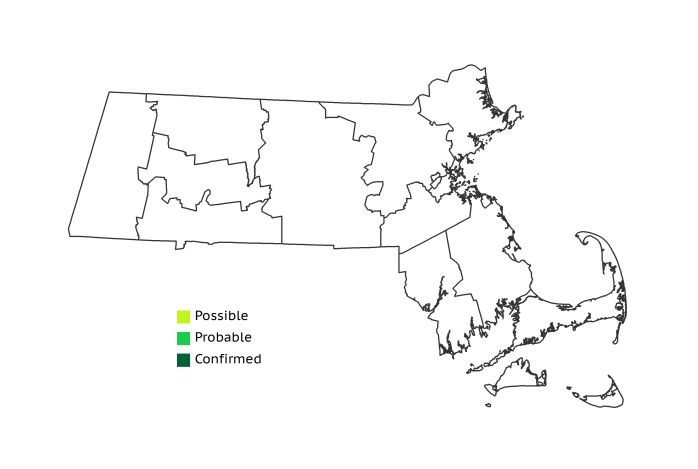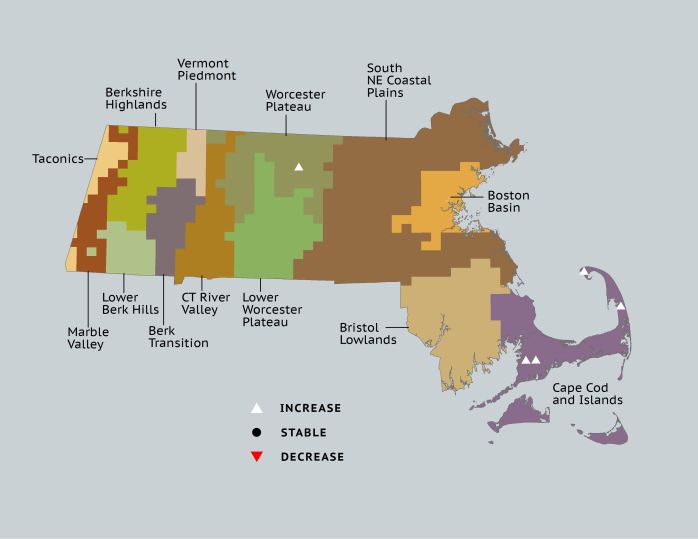Find a Bird
Clay-colored Sparrow
Spizella pallida

Very local, trend not established
“When first the discoverer draws aside the bush and exposes the nest with its complement his feelings are as of finding an exquisite casket of jewels.” – E.T. Seton, in Arthur Cleveland Bent’s Life Histories of North American Birds
The pale and subdued plumage of the Clay-colored Sparrow, elegant and beautifully subtle, is a rare sight in Massachusetts. As a typical denizen of the Great Plains scrubland, the Clay-colored Sparrow is a surprising species to find breeding in the Commonwealth of Massachusetts; however, its appearance here speaks to sweeping changes taking place in land use across North America.
Historic Status
It was Oliver L. Austin, Jr., from the Austin Ornithological Research Station in Wellfleet (located on the site of what is today Mass Audubon’s Wellfleet Bay Wildlife Sanctuary), who collected the first Clay-colored Sparrow in Massachusetts when two were taken in North Eastham on September 20, 1930 (Austin 1931). Many more sightings over the next two decades supported the speculation that a breeding range expansion was taking place in Ontario, and that there were possibly many more individuals passing through Massachusetts in migration than were being recorded. By the late 1960s, the first singing male Clay-colored Sparrows appeared in Massachusetts, signifying that breeding attempts might not be that far behind (Veit & Petersen 1993).
Atlas 1 Distribution
Clay-colored Sparrows had never nested in Massachusetts when the Atlas 1 surveys began, but their increasing rate of springtime appearances in the state was beginning to increasingly raise suspicions. The irregular occurrence of singing males that often presages the addition of a new species to a region’s list of breeding birds continued through the inter-Atlas period until eventually there was some activity that suggested more than a flirtation with the state.
Atlas 2 Distribution and Change
In both summer and winter, Massachusetts birders witnessed an increase in Clay-colored Sparrow occurrences. Atlas 2 finally gave the species an opportunity to have the spotlight. Five records during the Atlas period, 4 of them from Cape Cod, ultimately included a breeding Confirmation at the Massachusetts Military Reservation when on June 21, 2007, a nest with young was reported.
Atlas 1 Map

Atlas 2 Map

Atlas Change Map

Ecoregion Data
Atlas 1 | Atlas 2 | Change | ||||||
Ecoregion | # Blocks | % Blocks | % of Range | # Blocks | % Blocks | % of Range | Change in # Blocks | Change in % Blocks |
Taconic Mountains | 0 | 0.0 | 0.0 | 0 | 0.0 | 0.0 | 0 | 0.0 |
Marble Valleys/Housatonic Valley | 0 | 0.0 | 0.0 | 0 | 0.0 | 0.0 | 0 | 0.0 |
Berkshire Highlands | 0 | 0.0 | 0.0 | 0 | 0.0 | 0.0 | 0 | 0.0 |
Lower Berkshire Hills | 0 | 0.0 | 0.0 | 0 | 0.0 | 0.0 | 0 | 0.0 |
Vermont Piedmont | 0 | 0.0 | 0.0 | 0 | 0.0 | 0.0 | 0 | 0.0 |
Berkshire Transition | 0 | 0.0 | 0.0 | 0 | 0.0 | 0.0 | 0 | 0.0 |
Connecticut River Valley | 0 | 0.0 | 0.0 | 0 | 0.0 | 0.0 | 0 | 0.0 |
Worcester Plateau | 0 | 0.0 | 0.0 | 1 | 1.1 | 20.0 | 1 | 2.1 |
Lower Worcester Plateau | 0 | 0.0 | 0.0 | 0 | 0.0 | 0.0 | 0 | 0.0 |
S. New England Coastal Plains and Hills | 0 | 0.0 | 0.0 | 0 | 0.0 | 0.0 | 0 | 0.0 |
Boston Basin | 0 | 0.0 | 0.0 | 0 | 0.0 | 0.0 | 0 | 0.0 |
Bristol and Narragansett Lowlands | 0 | 0.0 | 0.0 | 0 | 0.0 | 0.0 | 0 | 0.0 |
Cape Cod and Islands | 0 | 0.0 | 0.0 | 4 | 2.8 | 80.0 | 4 | 3.3 |
Statewide Total | 0 | 0.0 | 0.0 | 5 | 0.5 | 100.0 | 5 | 0.6 |
Notes
The Clay-colored Sparrow shows a significant decreasing Breeding Bird Survey trend in the Eastern US overall.



